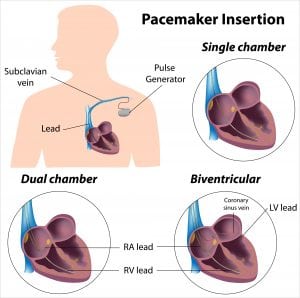
Cardiac Resynchronisation Therapy (CRT)
Sometimes referred to as biventricular pacing, Cardiac Resynchronisation Therapy (CRT) is advanced device therapy aimed to improve the function of the heart in patients with heart failure.
Up to a third of all patients with heart failure will have discoordination (dyssynchrony) in the contraction of the heart. One part of the heart (usually the back wall of the main pumping chamber – the left ventricle) is delayed in its contraction compared to other parts of the heart. This causes the heart to not contract in an organised and harmonious way and results in reduced efficiency. The result is worsening breathlessness, fatigue and fluid retention leading to a poor exercise capacity and often associated with a reduction in the quality of life.
In order to overcome this dyssynchrony, a special type of a pacemaker can be implanted which not only acts as a pacemaker but also a resynchronisation device. This involves the insertion of two leads, rather than the usual one, to the ventricles (pumping chambers of the heart) at different locations in the heart to attempt to obtain better contraction and thereby improve the function of the heart resulting in better efficiency, better exercise capacity and a better quality of life. CRT can be combined with an implantable cardiac defibrillator (ICD) as a single device to protect against the risk of life threatening heart rhythms.
Cardiac resynchronisation therapy (CRT) is implanted in a similar way to all pacemakers and devices. The procedure is usually performed under local anaesthetic and conscious sedation. The pacemaker leads (flexible wires) are advanced to the heart through a large vein under the collarbone and carefully positioned into the correct chambers of the heart with the aid of X-rays and firmly secured into place. The leads are then connected to the pacemaker or defibrillator device which is usually the size of a small matchbox, and then placed in a small pocket just under the skin. The wound, which is usually only 5cm long is carefully sutured and patients can be discharged either the same day or after an overnight stay. Devices are checked using programmers which communicate with the new CRT system and allow the doctor and technicians to adjust the device settings to optimise the performance of the pacemakers. Most patients can return to normal activities within 4 weeks of the implant and will require regular ongoing follow up and checks to ensure correct functioning of the devices.

We believe the best cardiac care can only be achieved by the best cardiologists in their fields, working together, for you and your heart. Our consultants are able to offer appointments throughout the week and at weekends.